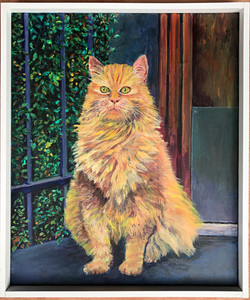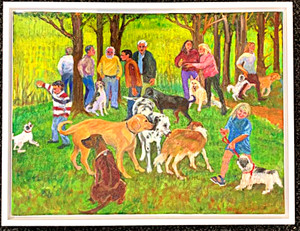
Thelma Appel, Temperance, from the Journey of the Tarot Series, 2009
Thelma AppelCONTACT GALLERY FOR PRICE
Description
Thelma Appel
Temperance, from the Journey of the Tarot Series, 2009
This work is part of Thelma Appel's original series of large paintings based upon the Major Arcana of the Tarot Deck, representing archetypes of human experience and characters - from a Kabbalistic perspective. In the traditional Rider Waite Tarot deck, TEMPERANCE is depicted as an angel. Here, Appel creatively reimagines the iconic "TEMPERANCE" -card as a mortal, a beautiful woman, at once modest and daring. As with the traditional Temperance card, each hand she holds a golden chalice and she is pouring water from one to the other, her gaze fixed on the stream of her own design. Everything in this card speaks of balance and harmony. Temperance is also a card of patience and biding ones time; all in good time, but not necessarily our time.
Combining her formal background in illustration, abstraction, landscape, figuration, and her interest in mysticism, spirituality and Kabbalah - Appel creates a uniquely original interpretation of the ages old Tarot desk, and is probably one of the only contemporary fine artists to undertake such an ambitious project.
Thelma Appel is an important landscape painter who has been working and teaching for more than five decades. Now nearing 80 years old, her work is being re-discovered by a new generation of collectors and curators. Most recently, she was selected from a roster of over 500 applications for a solo exhibition called "Landscapes and Cityscapes" at the Chashama Foundation in Manhattan. Appel's work was also featured in the exhibition “Road Trip: America through the Windshield”, at the Brattleboro Museum in Vermont, an exhibition at the Bennington Museum, at the Children's Museum of the Arts in New York City, and on the A & E Television Series "The Way Home." Thelma Appel was born in Tel Aviv Israel and studied art at Central St. Martin’s School of Art & Hornsey College of Art in London before emigrating to the United States, where she settled in Vermont, teaching at Bennington College and Parsons School of Design and exhibiting in museums and galleries throughout the region. Appel became known primarily for her paint-soaked brush strokes on large canvases that sought to recreate the energy, color and immediacy of the landscapes. Like many artists of the era, she was inspired by the Abstract Expressionists, including Helen Frankenthaler and Robert Motherwell whom she met at Bennington College. However, Appel wanted to express her feelings about Nature in a less amorphous and more recognizable way. In a recent documentary interview, Appel explained why she considers herself a Romantic landscape painter: "Not recording mimetically what lay before me, but trying to express the excitement I felt in response to nature by using paint-soaked brush strokes on a large canvas wherein the over-lapping layered strokes of color were metaphors for the contiguities found in nature. My early paintings sought to recreate the energy, color and immediacy of the landscapes...to convey a more raw "painterly" feeling within the image, rather than recording a particular scene or looking on from a distance. " During her time in Vermont, Appel's work was exhibited at The Robert Hull Fleming Museum at the University of Vermont, The Berkshire Museum in North Adams, MA, the University of Pennsylvania Fine Arts Gallery and in solo shows at Bennington College. In 1974 she was awarded a YADDO Fellowship, and in 1975 she founded the Bennington College Summer Painting Workshop, where many distinguished painters of the day, both abstract and representational, were invited to conduct master classes. Among them were Neil Welliver, John Button, Alice Neel, Larry Poons, Friedel Dzubas, Stanley Boxer, Elizabeth Murray and Doug Ohlson – a program that continued until 1980. (One of Appel's students during that era, was the renowned gallerist Matthew Marks.) Soon afterward, Appel began showing with the Kornblee Gallery, and later at Fischbach Gallery -- at the time the gallery of record for many renowned artists including Alex Katz. Appel also taught drawing at Parsons in NYC, and painting at Southern Vermont College. This work is part of Thelma Appel's impressive Cycle of the Tarot series.
Signed, titled, and dated on the verso of the canvas
Series: Journey of the Tarot






